A Review of Multi-Energy Systems from Resiliency and Equity Perspectives
Abstract
1. Introduction
1.1. Resilience: Concept and Energy Applications
1.2. Equity: Concept and Energy Applications
1.3. Challenges, Objectives, and Contributions
- Overarching scope: This is the first known review to systematically examine MES through the combined lenses of resilience and equity, which are highly interdependent and urgent subjects for sustainable energy transitions. By systematically analyzing the MES literature through both lenses, this review uncovers how technical decisions (e.g., energy storages, modeling strategies) align with or diverge from broader societal goals, offering a more holistic understanding of MES performance and guiding future research toward inclusive and climate-resilient energy solutions.
- Generalizable methodology: We introduce a structured classification and comprehensive statistical analysis framework that includes correlation analysis, categorical synthesis, and term clustering across 211 original MES studies. Very few review papers on MES, if any, employ a comprehensive statistical analysis framework like the one used herein. Previous reviews (e.g., [17,18,43,48,49,50,51], to name a few) focus on concepts, models, system typologies, and analysis methods, but do not apply structured statistics. Yet statistical analysis is essential for an unbiased review methodology by enabling objective identification of patterns, correlations, and gaps across a large body of the literature [52,53].
- Specific findings: We identify novel insights across both physical systems and research approaches for MES, such as the statistically significant association between equity-focused MES and fully renewable energy systems; the optimal resilience gains achieved in two-network MES configurations; the uniformity in multi-objective optimization approaches across resilience and equity lenses; and the contrasting statistically significant divergences in objective function metrics. Furthermore, we highlight underexplored modeling approaches and geographic gaps, particularly in low-income and extreme climate contexts.
2. Materials and Methods
2.1. Document Identification
2.2. Document Screening
2.3. Analysis and Synthesis
3. Results
3.1. Contextual Overview
3.2. Physical Systems
3.2.1. Source Energies
3.2.2. Major Equipment
3.2.3. Networks and End Uses
3.3. Research Approaches
3.3.1. Case Study Locations
3.3.2. Mathematical Models and Simulation Tools
3.3.3. Key Indicators and Metrics
4. Discussion
4.1. Contributions
4.2. Literature Context
4.3. Limitations
4.4. Research Trends and Future Work
- Objective Functions: First, cost-based objective functions dominate to date in both design and operation contexts. While financial costs are paramount to system success, researchers can explore other innovative metrics, including system-level factors such as R, exergy-based cycling index [162], or ecological fitness [163], which might capture higher-levels of network organization features that balance efficiency and resiliency goals.
- Stiff Solvers: Second, dynamic modeling with adaptive time-step solvers is lacking in resilience-focused work, while equity-focused work is lacking at large. Yet, some papers in this review [114,164,165,166] discuss the inherent challenge of capturing both fast and slow dynamics when modeling and simulating MES (i.e., mathematical problems with stiff systems of equations). These findings underscore the need for integrated modeling frameworks that can accurately and quickly simulate large systems of equations with stiff dynamics, and thus capture the complex, multi-scale dynamics present in MES. State-of-the-art research directions towards this end include stiff time-discretized numerical solvers (e.g., CVODE [167]) and quantized state solvers [168].
- Open Science: Lastly, while 39 papers leveraged open source software tools (i.e., Python, GAMS, Modelica, Julia), none of the papers made their code and data readily available, to our knowledge. At a minimum, papers listed data to be available upon request (e.g., [67,70,127]). To support knowledge transfer, foster research transparency and reproducibility, and enable accessible MES advancements, open code is critical [169]. Without it, physical principles need to be reconstructed with each new set of researchers, which greatly limits practical impacts. Future MES research should develop flexible simulation environments with readily-runnable open-source code to jointly advance resilience and equity for MES communities.
5. Conclusions
- For the overarching scope, this work is the first known review to systematically examine MES through the combined lenses of resilience and equity, two interdependent and urgent dimensions of sustainable energy transitions. By analyzing the MES literature from both perspectives, the review revealed how technical decisions—such as energy storage configurations and modeling strategies—align with or diverge from broader societal goals, offering a more holistic understanding of MES performance.
- Providing a generalizable methodology, the review introduced a structured classification and statistical analysis framework, including correlation analysis, categorical synthesis, and term clustering across 211 original MES studies. Unlike prior MES reviews, this approach enables objective identification of patterns and gaps, exemplifying a a foundation for future methodological development and practical implementation when reviewing the MES literature.
- Regarding the specific findings, the analysis uncovered novel insights across physical systems and research approaches, including the statistically significant association between equity-focused MES and fully renewable energy systems; the optimal resilience gains achieved in two-network configurations; and notable divergences in modeling approaches and optimization objectives between equity and resilience lenses. Additionally, the review identified critical research gaps, including the lack of case studies in low-income countries and extreme climates, and highlighted the need for innovation under such conditions.
Author Contributions
Funding
Data Availability Statement
Acknowledgments
Conflicts of Interest
Appendix A. Statistical Results
| Category 1 | Category 2 | n | p | ||
|---|---|---|---|---|---|
| Scope | Energy Class | 228 | 2 | 44.122 | <0.001 *** |
| Scope | Scale | 208 | 2 | 6.803 | 0.033 * |
| Scope | Income Level | 103 | 2 | 9.836 | 0.007 ** |
| Scope | Island Location | 66 | 1 | 2.452 | 0.117 |
| Scope | Rural Location | 66 | 1 | 2.834 | 0.092 |
| Scope | Demand-Side | 228 | 1 | 0.477 | 0.49 |
| Scope | Mobile Storage | 228 | 1 | 0.705 | 0.401 |
| Scope | Stochasticity | 228 | 1 | 4.749 | 0.029 * |
| Scope | Dynamics/ | 165 | 5 | 11.768 | 0.038 * |
| Scope | Load Shed Obj. | 141 | 1 | 8.261 | 0.004 ** |
| Scope | Emission Obj. | 141 | 1 | † | † |
| Scope | CapEx Obj. | 141 | 1 | 18.819 | <0.001 *** |
| Scope | MOO via Weights | 228 | 1 | 0.097 | 0.755 |
| Scope | MOO via Levels | 228 | 1 | 0.010 | 0.921 |
| Scope | Single Obj. | 228 | 1 | 1.000 | 0.317 |
| Scope | Design/Control | 228 | 3 | 30.958 | <0.001 *** |
| Energy Class | Scale | 193 | 4 | 11.122 | 0.025 * |
| Energy Class | Income Level | 90 | 4 | 13.037 | 0.011 * |
| Energy Class | Island Location | 49 | 2 | 5.688 | 0.058 |
| Energy Class | Rural Location | 49 | 2 | 6.752 | 0.034 * |
| Energy Class | Demand-Side | 211 | 2 | 0.049 | 0.976 |
| Energy Class | Mobile Storage | 211 | 2 | 1.715 | 0.424 |
| Energy Class | Stochasticity | 211 | 2 | 6.284 | 0.043 * |
| Energy Class | Dynamics/ | 151 | 10 | † | † |
| Energy Class | Load Shed Obj. | 129 | 2 | 6.112 | 0.047 * |
| Energy Class | Emission Obj. | 129 | 2 | 14.166 | 0.001 *** |
| Energy Class | CapEx Obj. | 129 | 2 | 8.458 | 0.015 * |
| Energy Class | MOO via Weights | 211 | 2 | 1.123 | 0.570 |
| Energy Class | MOO via Levels | 211 | 2 | 0.185 | 0.912000 |
| Energy Class | Single Obj. | 211 | 2 | 2.136 | 0.344 |
| Energy Class | Design/Control | 211 | 6 | 23.664 | 0.001 *** |
| Scale | Income Level | 88 | 4 | 6.004 | 0.199 |
| Scale | Island Location | 45 | 2 | 0.682 | 0.711 |
| Scale | Rural Location | 45 | 2 | 2.090 | 0.352 |
| Scale | Demand-Side | 193 | 2 | 1.817 | 0.403 |
| Scale | Mobile Storage | 193 | 2 | 0.689 | 0.709 |
| Scale | Stochasticity | 193 | 2 | 3.149 | 0.207 |
| Scale | Dynamics/ | 139 | 10 | † | † |
| Scale | Load Shed Obj. | 118 | 2 | 4.972 | 0.083 |
| Scale | Emission Obj. | 118 | 2 | 4.217 | 0.121 |
| Scale | CapEx Obj. | 118 | 2 | 7.281 | 0.026 * |
| Scale | MOO via Weights | 193 | 2 | 1.270 | 0.530 |
| Scale | MOO via Levels | 193 | 2 | 3.129 | 0.209 |
| Scale | Single Obj. | 193 | 2 | 2.087 | 0.352 |
| Scale | Design/Control | 193 | 6 | 28.299 | <0.001 *** |
| Category 1 | Category 2 | n | p | ||
|---|---|---|---|---|---|
| Income Level | Island Location | 39 | 2 | 8.919 | 0.012 * |
| Income Level | Rural Location | 39 | 2 | 11.622 | 0.003 ** |
| Income Level | Stochasticity | 90 | 2 | 1.012 | 0.603 |
| Income Level | Dynamics/ | 66 | 10 | † | † |
| Income Level | Load Shed Obj. | 51 | 2 | 0.239 | 0.888 |
| Income Level | Emission Obj. | 51 | 2 | 7.388 | 0.025 * |
| Income Level | CapEx Obj. | 51 | 2 | 0.923 | 0.630 |
| Income Level | MOO via Weights | 90 | 2 | 0.303 | 0.859 |
| Income Level | MOO via Levels | 90 | 2 | 2.859 | 0.239 |
| Income Level | Single Obj. | 90 | 2 | 1.625 | 0.444 |
| Income Level | Design/Control | 90 | 6 | 10.305 | 0.112 |
| Island Location | Rural Location | 49 | 1 | 20.002000 | <0.001 *** |
| Island Location | Stochasticity | 49 | 1 | † | † |
| Island Location | Dynamics/ | 35 | 3 | † | † |
| Island Location | Emission Obj. | 28 | 1 | † | † |
| Island Location | CapEx Obj. | 28 | 1 | † | † |
| Island Location | Single Obj. | 49 | 1 | † | † |
| Island Location | Design/Control | 49 | 3 | 5.960 | 0.114 |
| Rural Location | Stochasticity | 49 | 1 | † | † |
| Rural Location | Dynamics/ | 35 | 3 | 0.679 | 0.878 |
| Rural Location | Emission Obj. | 28 | 1 | 0.622 | 0.430 |
| Rural Location | CapEx Obj. | 28 | 1 | 2.489 | 0.115 |
| Rural Location | Single Obj. | 49 | 1 | 0.339 | 0.560 |
| Rural Location | Design/Control | 49 | 3 | 1.625 | 0.654 |
| Category 1 | Category 2 | n | p | ||
|---|---|---|---|---|---|
| Stochasticity | Dynamics/ | 151 | 5 | 7.383 | 0.194 |
| Stochasticity | Load Shed Obj. | 129 | 1 | 3.823 | 0.051 |
| Stochasticity | Emission Obj. | 129 | 1 | 2.493 | 0.114 |
| Stochasticity | CapEx Obj. | 129 | 1 | 0.226 | 0.634 |
| Stochasticity | Single Obj. | 211 | 1 | 8.862 | 0.003 ** |
| Stochasticity | Design/Control | 211 | 3 | 5.143 | 0.162 |
| Dynamics/ | Load Shed Obj. | 128 | 5 | 8.208 | 0.145 |
| Dynamics/ | Emission Obj. | 128 | 5 | † | † |
| Dynamics/ | CapEx Obj. | 128 | 5 | † | † |
| Dynamics/ | Single Obj. | 151 | 5 | 18.379 | 0.003 ** |
| Dynamics/ | Design/Control | 151 | 15 | † | † |
| Load Shed Obj. | Emission Obj. | 129 | 1 | 4.999 | 0.025 * |
| Load Shed Obj. | CapEx Obj. | 129 | 1 | 11.932 | 0.001 *** |
| Load Shed Obj. | Single Obj. | 129 | 1 | <0.001 | 0.998 |
| Load Shed Obj. | Design/Control | 129 | 3 | 8.816 | 0.032 * |
| Emission Obj. | CapEx Obj. | 129 | 1 | † | † |
| Emission Obj. | Single Obj. | 129 | 1 | 2.383 | 0.123 |
| Emission Obj. | Design/Control | 129 | 3 | 4.707 | 0.195 |
| CapEx Obj. | Single Obj. | 129 | 1 | 0.037 | 0.847 |
| CapEx Obj. | Design/Control | 129 | 3 | 30.668 | <0.001 *** |
| Demand-Side | Mobile Storage | 211 | 1 | 12.488 | <0.001 *** |
References
- IPCC. Summary for Policymakers. In Climate Change 2021: The Physical Science Basis. Contribution of Working Group I to the Sixth Assessment Report of the Intergovernmental Panel on Climate Change; Masson-Delmotte, V., Zhai, P., Pirani, A., Connors, S.L., Péan, C., Berger, S., Caud, N., Chen, Y., Goldfarb, L., Gomis, M.I., et al., Eds.; Cambridge University Press: Cambridge, UK, 2021; pp. 3–32. [Google Scholar] [CrossRef]
- Wang, J.; Zuo, W.; Rhode-Barbarigos, L.; Lu, X.; Wang, J.; Lin, Y. Literature review on modeling and simulation of energy infrastructures from a resilience perspective. Reliab. Eng. Syst. Saf. 2019, 183, 360–373. [Google Scholar] [CrossRef]
- United Nations. Transforming Our World: The 2030 Agenda for Sustainable Development; Technical Report; General Assembly: New York, NY, USA, 2015.
- Zhu, X.; Zhou, M.; Xiang, Z.; Zhang, L.; Sun, Y.; Li, G. Research on optimal configuration of energy hub considering system flexibility. In Proceedings of the PURPLE MOUNTAIN FORUM 2019-International Forum on Smart Grid Protection and Control; Xue, Y., Zheng, Y., Rahman, S., Eds.; Springer Nature: Singapore, 2020; Volume 585, pp. 243–257. [Google Scholar] [CrossRef]
- Yadoo, A.; Cruickshank, H. The role for low carbon electrification technologies in poverty reduction and climate change strategies: A focus on renewable energy mini-grids with case studies in Nepal, Peru and Kenya. Energy Policy 2012, 42, 591–602. [Google Scholar] [CrossRef]
- Cañizares, C.; Nathwani, J.; Kammen, D. Electricity for All: Issues, Challenges, and Solutions for Energy-Disadvantaged Communities. Proc. IEEE 2019, 107, 1775–1779. [Google Scholar] [CrossRef]
- Holling, C.S. Resilience and Stability of Ecological Systems. Annu. Rev. Ecol. Syst. 1973, 4, 1–23. [Google Scholar] [CrossRef]
- Odum, E.P.; Barrett, G.W. Fundamentals of Ecology, 5th ed.; Thomson Brooks/Cole: Belmont, CA, USA, 2005. [Google Scholar] [CrossRef]
- Woods, D.D.; Hollnagel, E. Resilience Engineering: Concepts and Precepts; Taylor & Francis Group: Abingdon, UK, 2006. [Google Scholar]
- Mottahedi, A.; Sereshki, F.; Ataei, M.; Qarahasanlou, A.N.; Barabadi, A. The resilience of critical infrastructure systems: A systematic literature review. Energies 2021, 14, 1571. [Google Scholar] [CrossRef]
- Maharjan, R.; Kato, H. Resilient supply chain network design: A systematic literature review. Transp. Rev. 2022, 42, 739–761. [Google Scholar] [CrossRef]
- Fletcher, D.; Sarkar, M. Psychological resilience: A review and critique of definitions, concepts, and theory. Eur. Psychol. 2013, 18, 12–23. [Google Scholar] [CrossRef]
- Bhamra, R.; Dani, S.; Burnard, K. Resilience: The concept, a literature review and future directions. Int. J. Prod. Res. 2011, 49, 5375–5393. [Google Scholar] [CrossRef]
- Tian, H.; Huang, G.; Chen, Y.; Li, G.; Li, X.; Bie, Z. Resilience-Based Optimal Placement Method for Integrated Electricity and Gas Energy System. In Proceedings of the 4th International Conference on HVDC, Xi’an, China, 6–9 November 2020; pp. 1188–1194. [Google Scholar] [CrossRef]
- Gazijahani, F.S.; Salehi, J.; Shafie-Khah, M. Benefiting from Energy-Hub Flexibilities to Reinforce Distribution System Resilience: A Pre- and Post-Disaster Management Model. IEEE Syst. J. 2022, 16, 3381–3390. [Google Scholar] [CrossRef]
- Tao, R.; Zhao, D.; Xu, C.; Wang, H.; Xia, X. Resilience Enhancement of Integrated Electricity-Gas-Heat Urban Energy System with Data Centres Considering Waste Heat Reuse. IEEE Trans. Smart Grid 2023, 14, 183–198. [Google Scholar] [CrossRef]
- Zhou, Y. Climate change adaptation with energy resilience in energy districts—A state-of-the-art review. Energy Build. 2023, 279, 112649. [Google Scholar] [CrossRef]
- He, J.; Yuan, Z.; Yang, X.; Huang, W.; Tu, Y.; Li, Y. Reliability Modeling and Evaluation of Urban Multi-Energy Systems: A Review of the State of the Art and Future Challenges. IEEE Access 2020, 8, 98887–98909. [Google Scholar] [CrossRef]
- Hussain, A.; Bui, V.H.; Kim, H.M. Microgrids as a resilience resource and strategies used by microgrids for enhancing resilience. Appl. Energy 2019, 240, 56–72. [Google Scholar] [CrossRef]
- Yang, B.; Ge, S.; Liu, H.; Li, J.; Zhang, S. Resilience assessment methodologies and enhancement strategies of multi-energy cyber-physical systems of the distribution network. IET Energy Syst. Integr. 2022, 4, 171–191. [Google Scholar] [CrossRef]
- Mejia-Giraldo, D.; Villarreal-Marimon, J.; Gu, Y.; He, Y.; Duan, Z.; Wang, L. Sustainability and Resiliency Measures for Long-Term Investment Planning in Integrated Energy and Transportation Infrastructures. J. Energy Eng. 2012, 138, 87–94. [Google Scholar] [CrossRef]
- The Rockefeller Foundation. City Resilience Index: Understanding and Measuring City Resilience; ARUP International Development: Hong Kong, China, 2016; p. 47. [Google Scholar]
- Dore, M.; Etkin, D. The importance of measuring the social costs of natural disasters at a time of climate change. Aust. J. Emerg. Manag. 2000, 15, 46–51. [Google Scholar]
- Field, C.B.; Barros, V.; Stocker, T.F.; Dahe, Q.; Jon Dokken, D.; Ebi, K.L.; Mastrandrea, M.D.; Mach, K.J.; Plattner, G.K.; Allen, S.K.; et al. Managing the Risks of Extreme Events and Disasters to Advance Climate Change Adaptation: Special Report of the Intergovernmental Panel on Climate Change, 1st ed.; Cambridge University Press: New York, NY, USA, 2012. [Google Scholar] [CrossRef]
- Kime, S.; Jacome, V.; Pellow, D.; Deshmukh, R. Evaluating equity and justice in low-carbon energy transitions. Environ. Res. Lett. 2023, 18, 123003. [Google Scholar] [CrossRef]
- UN DESA. The Sustainable Development Goals Report 2023: Special Edition; Technical Report; United Nations: New York, NY, USA, 2023.
- Kaygusuz, K. Energy for sustainable development: A case of developing countries. Renew. Sustain. Energy Rev. 2012, 16, 1116–1126. [Google Scholar] [CrossRef]
- Olówósejéjé, S.; Leahy, P.; Morrison, A.P. A practical approach for increased electrification, lower emissions and lower energy costs in Africa. Sustain. Futur. 2020, 2, 100022. [Google Scholar] [CrossRef]
- Liu, H.; Fu, H.; Sun, L.; Lee, C.; Yeatman, E.M. Hybrid energy harvesting technology: From materials, structural design, system integration to applications. Renew. Sustain. Energy Rev. 2021, 137, 110473. [Google Scholar] [CrossRef]
- Soudagar, M.E.M.; Ramesh, S.; Yunus Khan, T.M.; Almakayeel, N.; Ramesh, R.; Nik Ghazali, N.N.; Cuce, E.; Shelare, S. An overview of the existing and future state of the art advancement of hybrid energy systems based on PV-solar and wind. Int. J. Low-Carbon Technol. 2024, 19, 207–216. [Google Scholar] [CrossRef]
- Pandyaswargo, A.H.; Wibowo, A.D.; Onoda, H. Socio-techno-economic assessment to design an appropriate renewable energy system for remote agricultural communities in developing countries. Sustain. Prod. Consum. 2022, 31, 492–511. [Google Scholar] [CrossRef]
- Mwakitalima, I.J.; Rizwan, M.; Kumar, N. Standalone Solar Photovoltaic Electricity Supply to Rural Household in Tanzania. IETE J. Res. 2023, 69, 3871–3886. [Google Scholar] [CrossRef]
- Natividad, L.E.; Benalcazar, P. Hybrid Renewable Energy Systems for Sustainable Rural Development: Perspectives and Challenges in Energy Systems Modeling. Energies 2023, 16, 1328. [Google Scholar] [CrossRef]
- Gaslac, L.; Willis, S.; Quispe, G.; Raymundo, C. A hybrid energy system based on renewable energy for the electrification of low-income rural communities. IOP Conf. Ser. Earth Environ. Sci. 2018, 168, 012005. [Google Scholar] [CrossRef]
- Kgopana, K.; Popoola, O. Improved utilization of hybrid energy for low-income houses based on energy consumption pattern. AIMS Energy 2023, 11, 79–109. [Google Scholar] [CrossRef]
- Faridah, L.; Purwadi, A.; Ibrahim, M.H.; Rizqiawan, A. Study and Design of Hybrid Off-Grid Power System for Communal and Administrative Load at 3 Regions in Maluku, Indonesia. In Proceedings of the 4th IEEE Conference on Power Engineering and Renewable Energy, Solo, Indonesia, 29–31 October 2018; pp. 1–5. [Google Scholar] [CrossRef]
- Sanjel, N.; Baral, B. Modelling and analysis of decentralized energy systems with photovoltaic, micro-hydro, battery and diesel technology for remote areas of Nepal. Clean Energy 2021, 5, 690–703. [Google Scholar] [CrossRef]
- Dodo, U.A.; Ashigwuike, E.C.; Emechebe, J.N. Optimization of Standalone Hybrid Power System Incorporating Waste-to-electricity Plant: A Case Study in Nigeria. In Proceedings of the IEEE Nigeria 4th International Conference on Disruptive Technologies for Sustainable Development, Lagos, Nigeria, 15–17 May 2022; pp. 1–5. [Google Scholar] [CrossRef]
- Jansen, S.; Fremouw, M.; Meggers, F.; Guo, H.; Schmidt, R.R.; Maguerite, C.; Martinac, I.; Kayo, G.; Wang, C.; Gudmundsson, O.; et al. LowEx Communities—Optimised Performance of Energy Supply Systems with Exergy Principles (Annex 64); Technical Report September; Fraunhofer Verlag: Stuttgart, Germany, 2019. [Google Scholar]
- Pilpola, S.; Arabzadeh, V.; Mikkola, J.; Lund, P.D. Analyzing national and local pathways to carbon-neutrality from technology, emissions, and resilience perspectives—Case of Finland. Energies 2019, 12, 949. [Google Scholar] [CrossRef]
- Bartolini, A.; Carducci, F.; Muñoz, C.B.; Comodi, G. Energy storage and multi energy systems in local energy communities with high renewable energy penetration. Renew. Energy 2020, 159, 595–609. [Google Scholar] [CrossRef]
- Gudmundsson, O.; Thorsen, J.E.; Zhang, L. Cost analysis of district heating compared to its competing technologies. WIT Trans. Ecol. Environ. 2013, 176, 107–118. [Google Scholar] [CrossRef]
- Eladl, A.A.; El-Afifi, M.I.; El-Saadawi, M.M.; Sedhom, B.E. A review on energy hubs: Models, methods, classification, applications, and future trends. Alex. Eng. J. 2023, 68, 315–342. [Google Scholar] [CrossRef]
- Johnson, O.W.; Han, J.Y.C.; Knight, A.L.; Mortensen, S.; Aung, M.T.; Boyland, M.; Resurrección, B.P. Intersectionality and energy transitions: A review of gender, social equity and low-carbon energy. Energy Res. Soc. Sci. 2020, 70, 101774. [Google Scholar] [CrossRef]
- Arent, D.J.; Green, P.; Abdullah, Z.; Barnes, T.; Bauer, S.; Bernstein, A.; Berry, D.; Berry, J.; Burrell, T.; Carpenter, B.; et al. Challenges and opportunities in decarbonizing the U.S. energy system. Renew. Sustain. Energy Rev. 2022, 169, 112939. [Google Scholar] [CrossRef]
- Jafarizadeh, H.; Yamini, E.; Zolfaghari, S.M.; Esmaeilion, F.; Assad, M.E.H.; Soltani, M. Navigating challenges in large-scale renewable energy storage: Barriers, solutions, and innovations. Energy Rep. 2024, 12, 2179–2192. [Google Scholar] [CrossRef]
- Geidl, M.; Koeppel, G.; Favre-Perrod, P.; Klöckl, B.; Andersson, G.; Fröhlich, K. Energy Hubs for the Future. IEEE Power Energy Mag. 2007, 5, 24–30. [Google Scholar] [CrossRef]
- Mancarella, P. MES (multi-energy systems): An overview of concepts and evaluation models. Energy 2014, 65, 1–17. [Google Scholar] [CrossRef]
- Lasemi, M.A.; Arabkoohsar, A.; Hajizadeh, A.; Mohammadi-ivatloo, B. A comprehensive review on optimization challenges of smart energy hubs under uncertainty factors. Renew. Sustain. Energy Rev. 2022, 160, 112320. [Google Scholar] [CrossRef]
- Yao, R.; Hu, Y.; Varga, L. Applications of Agent-Based Methods in Multi-Energy Systems—A Systematic Literature Review. Energies 2023, 16, 2456. [Google Scholar] [CrossRef]
- Papadimitriou, C.; Somma, M.D.; Charalambous, C.; Caliano, M.; Palladino, V.; Borray, A.F.C.; González-Garrido, A.; Ruiz, N.; Graditi, G. A Comprehensive Review of the Design and Operation Optimization of Energy Hubs and Their Interaction with the Markets and External Networks. Energies 2023, 16, 4018. [Google Scholar] [CrossRef]
- Page, M.J.; McKenzie, J.E.; Bossuyt, P.M.; Boutron, I.; Hoffmann, T.C.; Mulrow, C.D.; Shamseer, L.; Tetzlaff, J.M.; Akl, E.A.; Brennan, S.E.; et al. The PRISMA 2020 statement: An updated guideline for reporting systematic reviews. BMJ 2021, 372, n71. [Google Scholar] [CrossRef]
- Kolaski, K.; Logan, L.R.; Ioannidis, J.P. Guidance to best tools and practices for systematic reviews. Syst. Rev. 2023, 16, 241–273. [Google Scholar] [CrossRef]
- Zhang, G.; Zhu, S.; Bai, X. Federated Learning-Based Multi-Energy Load Forecasting Method Using CNN-Attention-LSTM Model. Sustainability 2022, 14, 12843. [Google Scholar] [CrossRef]
- IFRIS; INRAE. CorTexT Platform; INRAE: Noisy-le-Grand, France, 2024.
- Moore, D.S.; McCabe, G.P. Introduction to the Practice of Statistics, 3rd ed.; W.H. Freeman: New York, NY, USA, 1999. [Google Scholar]
- World Bank Group. GNI per Capita, Atlas Method (Current US$); The World Bank Group: Washington DC, USA, 2022. [Google Scholar]
- Kottek, M.; Grieser, J.; Beck, C.; Rudolf, B.; Rubel, F. World map of the Köppen-Geiger climate classification updated. Meteorol. Z. 2006, 15, 259–263. [Google Scholar] [CrossRef] [PubMed]
- Karl Pearson, F.R.S. X. On the criterion that a given system of deviations from the probable in the case of a correlated system of variables is such that it can be reasonably supposed to have arisen from random sampling. Lond. Edinb. Dublin Philos. Mag. J. Sci. 1900, 50, 157–175. [Google Scholar] [CrossRef]
- Nakawiro, W. A co-optimization model of natural gas supply and electric power systems. Eng. J. 2019, 23, 135–148. [Google Scholar] [CrossRef]
- Wei, T.; Chu, X.; Liu, Y. Security Assessment of Interdependent Electricity-Gas Networks. In Proceedings of the IEEE Sustainable Power and Energy Conference, Chengdu, China, 23–25 November 2020; pp. 1484–1490. [Google Scholar] [CrossRef]
- Li, B.; Li, X.; Su, Q. A system and game strategy for the isolated island electric-gas deeply coupled energy network. Appl. Energy 2022, 306, 118013. [Google Scholar] [CrossRef]
- Arun Kumar, V.; Sharma, S.; Verma, A. Optimal DER Sizing and Dispatch of CHP for a Remote Educational Microgrid. In Proceedings of the 9th IEEE Power India International Conference, Sonepat, India, 28 February–1 March 2020; pp. 1–6. [Google Scholar] [CrossRef]
- Chen, W.; Chen, J.; Cai, Q.; Li, Z.; Hu, P. Optimized Scheduling of Biogas-photovoltaic-wind Rural Integrated Energy System Based on Energy Hub. In Proceedings of the 2023 IEEE International Conference on Power Science and Technology (ICPST), Kunming, China, 5–7 May 2023; pp. 709–716. [Google Scholar] [CrossRef]
- Cai, Q.; Xiang, K.; Chen, W.; Li, Z.; Hu, P. Collaborative Optimal Configuration Model of RIES with Biogas, Photovoltaic, and Wind. In Proceedings of the 7th International Conference on Green Energy and Applications, Singapore, 10–12 March 2023; pp. 53–58. [Google Scholar] [CrossRef]
- Nastasi, B.; Mazzoni, S.; Groppi, D.; Romagnoli, A.; Astiaso Garcia, D. Solar power-to-gas application to an island energy system. Renew. Energy 2021, 164, 1005–1016. [Google Scholar] [CrossRef]
- Mohseni, S.; Brent, A.C.; Burmester, D. Off-Grid Multi-Carrier Microgrid Design Optimisation: The Case of Rakiura–Stewart Island, Aotearoa–New Zealand. Energies 2021, 14, 6522. [Google Scholar] [CrossRef]
- Karaca, A.E.; Dincer, I. Development and evaluation of a solar based integrated hydrogen energy system for mobile applications. Energy Convers. Manag. 2023, 280, 116808. [Google Scholar] [CrossRef]
- Zhang, M.; Chen, X.; Chen, Y.; Jiang, S.; Shen, B. Combined cooling, heating, power and oxygen for hospital buildings employing photovoltaic power and liquefied methane. In Proceedings of the 5th International Conference on Electrical Engineering and Green Energy, Berlin, Germany, 8–11 June 2022; pp. 815–821. [Google Scholar] [CrossRef]
- Boulmrharj, S.; Bakhouya, M.; Khaidar, M. Green hydrogen for public transportation fueling and street lighting electrification: Towards more sustainable Moroccan cities. Sustain. Prod. Consum. 2023, 36, 217–232. [Google Scholar] [CrossRef]
- Mehrjerdi, H.; Hemmati, R.; Mahdavi, S.; Shafie-Khah, M.; Catalao, J.P. Multicarrier Microgrid Operation Model Using Stochastic Mixed Integer Linear Programming. IEEE Trans. Ind. Inform. 2022, 18, 4674–4687. [Google Scholar] [CrossRef]
- Ghasemi, A.A.; Gitizadeh, M.; Kamwa, I.; Ghareghani, O. Resiliency constraint proactive scheduling against hurricane in multiple energy carrier microgrid. IET Gener. Transm. Distrib. 2022, 16, 4096–4114. [Google Scholar] [CrossRef]
- Masrur, H.; Shafie-khah, M.; Hossain, M.J.; Senjyu, T. Multi-energy Microgrids Incorporating EV Integration: Optimal Design and Resilient Operation. IEEE Trans. Smart Grid 2022, 13, 3508–3518. [Google Scholar] [CrossRef]
- Tan, C.; Yu, M.; Wang, J.; Geng, S.; Niu, D.; Tan, Z. Feasibility study on the construction of multi-energy complementary systems in rural areas—Eastern, central, and western parts of China are taken as examples. Energy 2022, 249, 123571. [Google Scholar] [CrossRef]
- Seyyedi, A.Z.G.; Armand, M.J.; Akbari, E.; Moosanezhad, J.; Khorasani, F.; Raeisinia, M. A non-linear resilient-oriented planning of the energy hub with integration of energy storage systems and flexible loads. J. Energy Storage 2022, 51, 104397. [Google Scholar] [CrossRef]
- Kolker, A.; Garber-Slaght, R.; Anderson, B.; Reber, T.; Zyatitsky, K.; Pauling, H. Geothermal Energy and Resilience in Arctic Countries; Technical Report NREL/TP-5700-80928; NREL: Golden, CO, USA, 2022. [Google Scholar]
- Raza, A.; Malik, T.N.; Khan, M.F.N.; Ali, S. Energy management in residential buildings using energy hub approach. Build. Simul. 2020, 13, 363–386. [Google Scholar] [CrossRef]
- Senkel, A.; Bode, C.; Schmitz, G. Quantification of the resilience of integrated energy systems using dynamic simation. Reliab. Eng. Syst. Saf. 2021, 209, 107447. [Google Scholar] [CrossRef]
- Zhao, J.; Xiong, J.; Yu, H.; Bu, Y.; Zhao, K.; Yan, J.; Li, P.; Wang, C. Reliability evaluation of community integrated energy systems based on fault incidence matrix. Sustain. Cities Soc. 2022, 80, 103769. [Google Scholar] [CrossRef]
- Temiz, M.; Dincer, I. Design and analysis of nuclear and solar-based energy, food, fuel, and water production system for an indigenous community. J. Clean. Prod. 2021, 314, 127890. [Google Scholar] [CrossRef]
- Ju, Y.; Jin, M.; Wang, J.; Yang, J.; Dong, M.; Li, D.; Shi, K.; Zhang, H. Research on optimal dispatching strategy for micro-energy-grid of protected agriculture. Appl. Sci. 2019, 9, 3929. [Google Scholar] [CrossRef]
- Lv, C.; Liang, R.; Jin, W.; Chai, Y.; Yang, T. Multi-stage resilience scheduling of electricity-gas integrated energy system with multi-level decentralized reserve. Appl. Energy 2022, 317, 119165. [Google Scholar] [CrossRef]
- Cai, A.; Sun, B.; Wang, R.; Wang, M.; Chi, Q.; Yang, L.; Wei, D. Double-Layer Cycle Capacity Optimization Model of Rural Biogas-Solar-Wind Integrated Energy System. In Proceedings of the 4th International Conference on Smart Power and Internet Energy Systems, Beijing, China, 9–12 December 2022; pp. 1648–1654. [Google Scholar] [CrossRef]
- Zheng, T.; Dai, Z.; Zhao, J.; Yao, J.; Wang, Y.; Zhang, K. Economic dispatch strategy of multi-energy system considering N-1 security constraints. In Proceedings of the 4th IEEE Conference on Energy Internet and Energy System Integration, Wuhan, China, 30 October–1 November 2020; pp. 1976–1980. [Google Scholar] [CrossRef]
- Ren, H.; Jiang, Z.; Wu, Q.; Li, Q.; Yang, Y. Integrated optimization of a regional integrated energy system with thermal energy storage considering both resilience and reliability. Energy 2022, 261, 125333. [Google Scholar] [CrossRef]
- Sui, Q.; Wei, F.; Wu, C.; Lin, X.; Li, Z. Self-Sustaining of Post-Disaster Pelagic Island Energy Systems with Mobile Multi-Energy Storages. IEEE Trans. Smart Grid 2023, 14, 2645–2655. [Google Scholar] [CrossRef]
- Chen, Y.; Zhang, Y.; Wang, J.; Lu, Z. Optimal operation for integrated electricity-heat system with improved heat pump and storage model to enhance local energy utilization. Energies 2020, 13, 6729. [Google Scholar] [CrossRef]
- Shao, Z.; Cao, X.; Zhai, Q.; Guan, X. Risk-constrained planning of rural-area hydrogen-based microgrid considering multiscale and multi-energy storage systems. Appl. Energy 2023, 334, 120682. [Google Scholar] [CrossRef]
- Guo, Z.; Li, G.; Zhou, M.; Feng, W. Resilient Configuration Approach of Integrated Community Energy System Considering Integrated Demand Response under Uncertainty. IEEE Access 2019, 7, 87513–87533. [Google Scholar] [CrossRef]
- Gabbar, H.A. Resiliency analysis of hybrid energy systems within interconnected infrastructures. Energies 2021, 14, 7499. [Google Scholar] [CrossRef]
- Herenčić, L.; Melnjak, M.; Capuder, T.; Andročec, I.; Rajšl, I. Techno-economic and environmental assessment of energy vectors in decarbonization of energy islands. Energy Convers. Manag. 2021, 236, 114064. [Google Scholar] [CrossRef]
- Yang, H.; Xiong, T.; Qiu, J.; Qiu, D.; Dong, Z.Y. Optimal operation of DES/CCHP based regional multi-energy prosumer with demand response. Appl. Energy 2016, 167, 353–365. [Google Scholar] [CrossRef]
- Zakernezhad, H.; Nazar, M.S.; Shafie-khah, M.; Catalão, J.P. Optimal resilient operation of multi-carrier energy systems in electricity markets considering distributed energy resource aggregators. Appl. Energy 2021, 299, 117271. [Google Scholar] [CrossRef]
- Li, B.; Li, J. Deploy Mobile Hydrogen Trucks to Improve Energy Supply System Resilience. In Proceedings of the 5th IEEE Conference on Energy Internet and Energy System Integration, Taiyuan, China, 22–25 October 2021; pp. 2258–2263. [Google Scholar] [CrossRef]
- Li, B.; Li, J.; Jian, B. Improve multi-energy supply microgrid resilience using mobile hydrogen trucks based on transportation network. eTransportation 2023, 18, 100265. [Google Scholar] [CrossRef]
- Tao, Y.; Qiu, J.; Lai, S.; Sun, X.; Zhao, J. Vulnerability Assessment of Coupled Transportation and Multi-Energy Networks Considering Electric and Hydrogen Vehicles. IEEE Trans. Intell. Transp. Syst. 2023, 24, 12614–12626. [Google Scholar] [CrossRef]
- Valipour, E.; Nourollahi, R.; Taghizad-Tavana, K.; Nojavan, S.; Alizadeh, A. Risk Assessment of Industrial Energy Hubs and Peer-to-Peer Heat and Power Transaction in the Presence of Electric Vehicles. Energies 2022, 15, 8920. [Google Scholar] [CrossRef]
- Benjamin, M.F.D.; Cayamanda, C.D.; Belmonte, B.A.; Tan, R.R.; Razon, L.F. A risk-based criticality analysis in bioenergy parks using P-graph method. Chem. Eng. Trans. 2016, 52, 1243–1248. [Google Scholar] [CrossRef]
- Benjamin, M.F.; Ubando, A.; Razon, L.; Tan, R.R. Analyzing the disruption resilience of microalgal multi-functional Bioenergy systems using dynamic inoperability input-output modeling. Chem. Eng. Trans. 2015, 45, 1579–1584. [Google Scholar] [CrossRef]
- Ji, L.; Liang, X.; Xie, Y.; Huang, G.; Wang, B. Optimal design and sensitivity analysis of the stand-alone hybrid energy system with PV and biomass-CHP for remote villages. Energy 2021, 225, 120323. [Google Scholar] [CrossRef]
- Benjamin, M.F.D.; Tan, R.R.; Razon, L.F. Probabilistic multi-disruption risk analysis in bioenergy parks via physical input-output modeling and analytic hierarchy process. Sustain. Prod. Consum. 2015, 1, 22–33. [Google Scholar] [CrossRef]
- Mansouri, M.; Madi, H.; Breuhaus, P. Establishment of a Baseline Integrated Energy System To Decarbonise Geographical Islands. In Proceedings of the ASME Turbomachinery Technical Conference and Exposition, Rotterdam, The Netherlands, 13–17 June 2022; pp. 1–10. [Google Scholar] [CrossRef]
- Ray, A.; Jana, K.; De, S. Polygeneration for an off-grid Indian village: Optimization by economic and reliability analysis. Appl. Therm. Eng. 2017, 116, 182–196. [Google Scholar] [CrossRef]
- Gupta, K.K.; Rehman, A.; Sarviya, R.M. Bio-fuels for the gas turbine: A review. Renew. Sustain. Energy Rev. 2010, 14, 2946–2955. [Google Scholar] [CrossRef]
- Neuling, U.; Kaltschmitt, M. Review of biofuel production - Feedstock, processes and markets. J. Oil Palm Res. 2017, 29, 137–167. [Google Scholar] [CrossRef]
- König, S.; Bchini, Q.; McKenna, R.; Köppel, W.; Bachseitz, M.; Michaelis, J. Spatially-resolved analysis of the challenges and opportunities of Power-to-Gas (PtG) in Baden-Württemberg until 2040. In Proceedings of the 11th International Renewable Energy Storage Conference, Düsseldorf, Germany, 14–16 March 2017; Volmue 135, pp. 434–444. [Google Scholar] [CrossRef]
- Zhao, P.; Gu, C.; Hu, Z.; Xie, D.; Hernando-Gil, I.; Shen, Y. Distributionally Robust Hydrogen Optimization with Ensured Security and Multi-Energy Couplings. IEEE Trans. Power Syst. 2021, 36, 504–513. [Google Scholar] [CrossRef]
- Qiu, D.; Wang, Y.; Zhang, T.; Sun, M.; Strbac, G. Hierarchical multi-agent reinforcement learning for repair crews dispatch control towards multi-energy microgrid resilience. Appl. Energy 2023, 336, 120826. [Google Scholar] [CrossRef]
- Gu, W.; Ding, S.; Lu, S.; Zhao, P.; Zou, D.; Qiu, Y.; Yu, R.; Sheng, L. Coordinated Heat and Power Cyber-Attacks with Time Window Matching Strategy. IEEE Trans. Smart Grid 2023, 14, 2747–2761. [Google Scholar] [CrossRef]
- Iniyan, S.; Jagadeesan, T.R. A comparative study of critical factors influencing the renewable energy systems use in the Indian context. Renew. Energy 1997, 11, 299–317. [Google Scholar] [CrossRef]
- Xu, L.; Wang, S.; Wang, Z.; Qi, X. Dual-layer self-healing strategy for standalone building energy systems: A case study of a tropical island. Energy Build. 2023, 283, 112827. [Google Scholar] [CrossRef]
- Attardo, G.; Longo, S.; Montana, F.; Sanseverino, E.R.; Tran, Q.T.T.; Zizzo, G. Urban energy hubs economic optimization and environmental comparison in Italy and Vietnam. In Proceedings of the IEEE 4th International Forum on Research and Technologies for Society and Industry (RTSI), Palermo, Italy, 10–13 September 2018; pp. 1–6. [Google Scholar] [CrossRef]
- Wu, J.; Gu, J.; Liu, S.; Jin, Z. Strategies for improving resilience of regional integrated energy systems in the prevention–resistance phase of integration. Prot. Control Mod. Power Syst. 2023, 8, 1–8. [Google Scholar] [CrossRef]
- Carvallo, C.; Jalil-Vega, F.; Moreno, R. A multi-energy multi-microgrid system planning model for decarbonisation and decontamination of isolated systems. Appl. Energy 2023, 343, 121143. [Google Scholar] [CrossRef]
- Lu, Y.; Yang, K. An accurate and efficient quasi-dynamic simulation method of electricity-heat multi-energy systems. Front. Energy Res. 2023, 11, 1229438. [Google Scholar] [CrossRef]
- Chen, Y.; Chen, Z.; Chen, Z.; Yuan, X. Dynamic modeling of solar-assisted ground source heat pump using Modelica. Appl. Therm. Eng. 2021, 196, 117324. [Google Scholar] [CrossRef]
- Wiegel, B.; Steffen, T.; Babazadeh, D.; Becker, C. Towards a more comprehensive open-source model for interdisciplinary smart integrated energy systems. In Proceedings of the 11th Workshop on Modelling and Simulation of Cyber-Physical Energy Systems (MSCPES), San Antonio, TX, USA, 9 May 2023; pp. 1–7. [Google Scholar] [CrossRef]
- Li, X.; Sun, B.; Ju, W.; Zhang, H.; Wang, R. Capacity Configuration Model of Biogas-based Integrated Energy System. In Proceedings of the 2021 IEEE 4th International Electrical and Energy Conference, CIEEC 2021, Wuhan, China, 28–30 May 2021. [Google Scholar] [CrossRef]
- Saravi, V.S.; Kalantar, M.; Anvari-Moghaddam, A. Resilience-constrained expansion planning of integrated power–gas–heat distribution networks. Appl. Energy 2022, 323, 119315. [Google Scholar] [CrossRef]
- Chen, H.; Meng, K.; Qiu, J.; Dong, Z.Y. Expansion Co-Planning of Integrated Electricity-Heat-Gas Networks in District Energy Systems. In Proceedings of the IEEE Power and Energy Society General Meeting, Portland, OR, USA, 5–10 August 2018; pp. 1–5. [Google Scholar] [CrossRef]
- Lu, S.; Li, Y.; Ding, S.; Gu, W.; Xu, Y.; Song, M. Combined Electrical and Heat Load Restoration Based on Bi-Objective Distributionally Robust Optimization. IEEE Trans. Ind. Inform. 2023, 19, 9239–9252. [Google Scholar] [CrossRef]
- Li, B.; Roche, R.; Miraoui, A. System resilience improvement using multiple energy supply systems under natural disasters. In Proceedings of the IECON Proceedings (Industrial Electronics Conference), Florence, Italy, 24–27 October 2016; pp. 3912–3917. [Google Scholar] [CrossRef]
- Zhao, P.; Gu, C.; Cao, Z.; Shen, Y.; Teng, F.; Chen, X.; Wu, C.; Huo, D.; Xu, X.; Li, S. Data-Driven Multi-Energy Investment and Management under Earthquakes. IEEE Trans. Ind. Inform. 2021, 17, 6939–6950. [Google Scholar] [CrossRef]
- Wang, Y.; Guo, L.; Ma, Y.; Han, X.; Xing, J.; Miao, W.Q.; Wang, H. Study on operation optimization of decentralized integrated energy system in northern rural areas based on multi-objective. Energy Rep. 2022, 8, 3063–3084. [Google Scholar] [CrossRef]
- Bai, L.; Li, F.; Jiang, T.; Jia, H. Robust Scheduling for Wind Integrated Energy Systems Considering Gas Pipeline and Power Transmission N-1 Contingencies. IEEE Trans. Power Syst. 2017, 32, 1582–1584. [Google Scholar] [CrossRef]
- Jiang, X.; Chen, J.; Chen, M.; Wei, Z. Multi-stage dynamic post-disaster recovery strategy for distribution networks considering integrated energy and transportation networks. CSEE J. Power Energy Syst. 2021, 7, 408–420. [Google Scholar] [CrossRef]
- Parvin, M.; Yousefi, H.; Noorollahi, Y. Techno-economic optimization of a renewable micro grid using multi-objective particle swarm optimization algorithm. Energy Convers. Manag. 2023, 277, 116639. [Google Scholar] [CrossRef]
- Feng, C.; Wang, W.; Wang, Z.; Li, C.; Yang, W.; Wei, S. Research on Capacity Allocation Method for Multi-scenario Rural Integrated Energy System. In Proceedings of the 2nd International Conference on New Energy and Power Engineering (ICNEPE 2022), Qingdao, China, 18–20 November 2022; Volume 2474, p. 012022. [Google Scholar] [CrossRef]
- Zhang, Y.; Hu, Y.; Ma, J.; Bie, Z. A mixed-integer linear programming approach to security-constrained co-optimization expansion planning of natural gas and electricity transmission systems. IEEE Trans. Power Syst. 2018, 33, 6368–6378. [Google Scholar] [CrossRef]
- Liu, Z.; Yu, H.; Liu, R.; Wang, M.; Li, C. Configuration optimization model for data-center-park-integrated energy systems under economic, reliability, and environmental considerations. Energies 2020, 13, 448. [Google Scholar] [CrossRef]
- Yodo, N.; Arfin, T. A resilience assessment of an interdependent multi-energy system with microgrids. Sustain. Resilient Infrastruct. 2021, 6, 42–55. [Google Scholar] [CrossRef]
- Liu, X.; Liu, F.; Li, N.; Mu, H.; Li, L. Hierarchical multi-objective design of regional integrated energy system under heterogeneous low-carbon policies. Sustain. Prod. Consum. 2022, 32, 357–377. [Google Scholar] [CrossRef]
- Gargari, M.Z.; Hagh, M.T.; Zadeh, S.G. Preventive maintenance scheduling of multi energy microgrid to enhance the resiliency of system. Energy 2021, 221, 119782. [Google Scholar] [CrossRef]
- Pazouki, S.; Naderi, E.; Asrari, A. A remedial action framework against cyberattacks targeting energy hubs integrated with distributed energy resources. Appl. Energy 2021, 304, 117895. [Google Scholar] [CrossRef]
- Li, Y.; Li, T.; Zhang, H.; Xie, X.; Sun, Q. Distributed Resilient Double-Gradient-Descent Based Energy Management Strategy for Multi-Energy System Under DoS Attacks. IEEE Trans. Netw. Sci. Eng. 2022, 9, 2301–2316. [Google Scholar] [CrossRef]
- Zhao, P.; Li, S.; Hu, P.J.H.; Cao, Z.; Gu, C.; Xie, D.; Zeng, D.D. Coordinated Cyber Security Enhancement for Grid-Transportation Systems with Social Engagement. IEEE Trans. Emerg. Top. Comput. Intell. 2022, 8, 3199–3213. [Google Scholar] [CrossRef]
- Masrur, H.; Gamil, M.M.; Islam, M.R.; Muttaqi, K.M.; Lipu, M.S.; Senjyu, T. An Optimized and Outage-Resilient Energy Management Framework for Multicarrier Energy Microgrids Integrating Demand Response. IEEE Trans. Ind. Appl. 2022, 58, 4171–4180. [Google Scholar] [CrossRef]
- Edwin, M.; Joseph Sekhar, S. Thermo-economic assessment of hybrid renewable energy based cooling system for food preservation in hilly terrain. Renew. Energy 2016, 87, 493–500. [Google Scholar] [CrossRef]
- Moslehi, S.; Reddy, T.A. A new quantitative life cycle sustainability assessment framework: Application to integrated energy systems. Appl. Energy 2019, 239, 482–493. [Google Scholar] [CrossRef]
- Elkadeem, M.R.; Abido, M.A. Optimal planning and operation of grid-connected PV/CHP/battery energy system considering demand response and electric vehicles for a multi-residential complex building. J. Energy Storage 2023, 72, 108198. [Google Scholar] [CrossRef]
- Ghezelbash, A.; Khaligh, V.; Anvari-Moghaddam, A. A cyber-secure model to decentralized co-expansion planning of gas and electricity networks. Int. J. Energy Res. 2021, 45, 13414–13428. [Google Scholar] [CrossRef]
- Guangtao, N.; Mingfan, C.; Linwei, L.; Jinhong, M.; Shuwei, M. Optimization of integrated energy supplying system in grid-connected island. In Proceedings of the IEEE Conference on Energy Internet and Energy System Integration (EI2), Beijing, China, 26–28 November 2017; pp. 1–5. [Google Scholar] [CrossRef]
- Postnikov, I.; Stennikov, V.; Penkovskii, A. Integrated energy supply schemes on basis of cogeneration plants and wind power plants. In Proceedings of the 10th International Conference on Applied Energy (ICAE2018), Hong Kong, China, 22–25 August 2019; Volume 158, pp. 154–159. [Google Scholar] [CrossRef]
- Kashanizadeh, B.; Shourkaei, H.M.; Fotuhi-Firuzabad, M. Short-term resilience-oriented enhancement in smart multiple residential energy system using local electrical storage system, demand side management and mobile generators. J. Energy Storage 2022, 52, 104825. [Google Scholar] [CrossRef]
- Chaudry, M.; Wu, J.; Jenkins, N. A sequential Monte Carlo model of the combined GB gas and electricity network. Energy Policy 2013, 62, 473–483. [Google Scholar] [CrossRef]
- Wang, S.; Shao, C.; Ding, Y.; Yan, J. Operational reliability of multi-energy customers considering service-based self-scheduling. Appl. Energy 2019, 254, 113531. [Google Scholar] [CrossRef]
- Kou, Y.; Bie, Z.; Li, G.; Liu, F.; Jiang, J. Reliability evaluation of multi-agent integrated energy systems with fully distributed communication. Energy 2021, 224, 120123. [Google Scholar] [CrossRef]
- Dou, Z.; Zhang, C.; Dai, R.; Wei, S.; Zhang, J.; Wang, L.; Jiang, C. Resilience enhancement strategy of multi-energy coupling distribution network considering movable energy storage equipment. J. Phys. Conf. Ser. 2023, 2418. [Google Scholar] [CrossRef]
- Maio, F.D.; Tonicello, P.; Zio, E. A Modeling and Analysis Framework for Integrated Energy Systems Exposed to Climate Change-Induced NaTech Accidental Scenarios. Sustainability 2022, 14, 786. [Google Scholar] [CrossRef]
- Li, B.; Chen, Y.; Wei, W.; Hou, Y.; Mei, S. Enhancing resilience of emergency heat and power supply via deployment of LNG tube trailers: A mean-risk optimization approach. Appl. Energy 2022, 318, 119204. [Google Scholar] [CrossRef]
- Billinton, R.; Li, W. Basic Concepts of Power System Reliability Evaluation. In Reliability Assessment of Electric Power Systems Using Monte Carlo Methods, 1st ed.; Springer: Berlin/Heidelberg, Germany, 1994; Chapter 2; pp. 9–31. [Google Scholar] [CrossRef]
- Boroujeni, H.F.; Eghtedari, M.; Bastaki, M.A.; Behzadipour, E.; Boroujeni, H.F.; Abdollahi, M. Calculation of generation system reliability index: Loss of Load Probability. Life Sci. J. 2012, 9, 4903–4908. [Google Scholar]
- Al-Shaalan, A.M. Reliability evaluation in generation expansion planning based on the expected energy not served. J. King Saud. Univ.-Eng. Sci. 2012, 24, 11–18. [Google Scholar] [CrossRef]
- Bichpuriya, Y.K.; Navalkar, P.V.; Soman, S.A. Benchmarking of reliability indices for electricity distribution utilities: Approach and discussion. In Proceedings of the IET Conference on Reliability of Transmission and Distribution Networks (RTDN 2011), London, UK, 22–24 November 2011; pp. 1–6. [Google Scholar] [CrossRef]
- Zhao, P.; Gu, C.; Cao, Z.; Xie, D.; Teng, F.; Li, J.; Chen, X.; Wu, C.; Yu, D.; Xu, X.; et al. A Cyber-Secured Operation for Water-Energy Nexus. IEEE Trans. Power Syst. 2021, 36, 3105–3117. [Google Scholar] [CrossRef]
- Wang, J.; Zheng, X.; Tai, N.; Yang, Z.; Wang, J.; Wei, W.; Li, L. Resilience-oriented multi-energy complementary microgrid robust optimal operation strategy considering the uncertainty. In Proceedings of the 8th Renewable Power Generation Conference (RPG 2019), Shanghai, China, 24–25 October 2019; pp. 1–7. [Google Scholar] [CrossRef]
- Alasvand Javadi, E.; Joorabian, M.; Barati, H. A bi-level optimization framework for resilience enhancement of electricity and natural gas networks with participation of energy hubs. Int. J. Electr. Power Energy Syst. 2022, 142, 108312. [Google Scholar] [CrossRef]
- Hosseini, S.E.; Ahmarinejad, A.; Tabrizian, M.; Bidgoli, M.A. Resilience enhancement of integrated electricity-gas-heating networks through automatic switching in the presence of energy storage systems. J. Energy Storage 2022, 47, 103662. [Google Scholar] [CrossRef]
- Ravadanegh, S.N.; Jamali, S.; Mohammadi Vaniar, A. Multi-infrastructure energy systems resiliency assessment in the presence of multi-hazards disasters. Sustain. Cities Soc. 2022, 79, 103687. [Google Scholar] [CrossRef]
- Rezaei, S.; Ghasemi, A. Stochastic scheduling of resilient interconnected energy hubs considering peer-to-peer energy trading and energy storages. J. Energy Storage 2022, 50, 104665. [Google Scholar] [CrossRef]
- Alasvand Javadi, E.; Joorabian, M.; Barati, H. A sustainable framework for resilience enhancement of integrated energy systems in the presence of energy storage systems and fast-acting flexible loads. J. Energy Storage. 2022, 49, 104099. [Google Scholar] [CrossRef]
- Hinkelman, K.; Anbarasu, S.; Zuo, W. Exergy-based ecological network analysis for building and community energy systems. Energy Build. 2024, 303, 113807. [Google Scholar] [CrossRef]
- Chatterjee, A.; Layton, A. Mimicking nature for resilient resource and infrastructure network design. Reliab. Eng. Syst. Saf. 2020, 204, 107142. [Google Scholar] [CrossRef]
- Maihemuti, S.; Wang, W.; Wang, H.; Wu, J.; Zhang, X. Dynamic Security and Stability Region under Different Renewable Energy Permeability in IENGS System. IEEE Access 2021, 9, 76531. [Google Scholar] [CrossRef]
- Huang, W.; Zhang, X.; Li, K.; Zhang, N.; Strbac, G.; Kang, C. Resilience Oriented Planning of Urban Multi-Energy Systems with Generalized Energy Storage Sources. IEEE Trans. Power Syst. 2022, 37, 2906–2918. [Google Scholar] [CrossRef]
- Bao, M.; Ding, Y.; Sang, M.; Li, D.; Shao, C.; Yan, J. Modeling and evaluating nodal resilience of multi-energy systems under windstorms. Appl. Energy 2020, 270, 115136. [Google Scholar] [CrossRef]
- Hindmarsh, A.C.; Serban, R.; Reynolds, D.R. User Documentation for CVODE v5.1.0 (SUNDIALS v5.1.0); Technical Report; Lawrence Livermore National Laboratory: Livermore, CA, USA, 2020. [Google Scholar]
- Cellier, F.E.; Kofman, E. Continuous System Simulation; Springer: New York, NY, USA, 2006. [Google Scholar]
- Colavizza, G.; Cadwallader, L.; LaFlamme, M.; Dozot, G.; Lecorney, S.; Rappo, D.; Hrynaszkiewicz, I. An analysis of the effects of sharing research data, code, and preprints on citations. PLoS ONE 2024, 19, e0311493. [Google Scholar] [CrossRef]


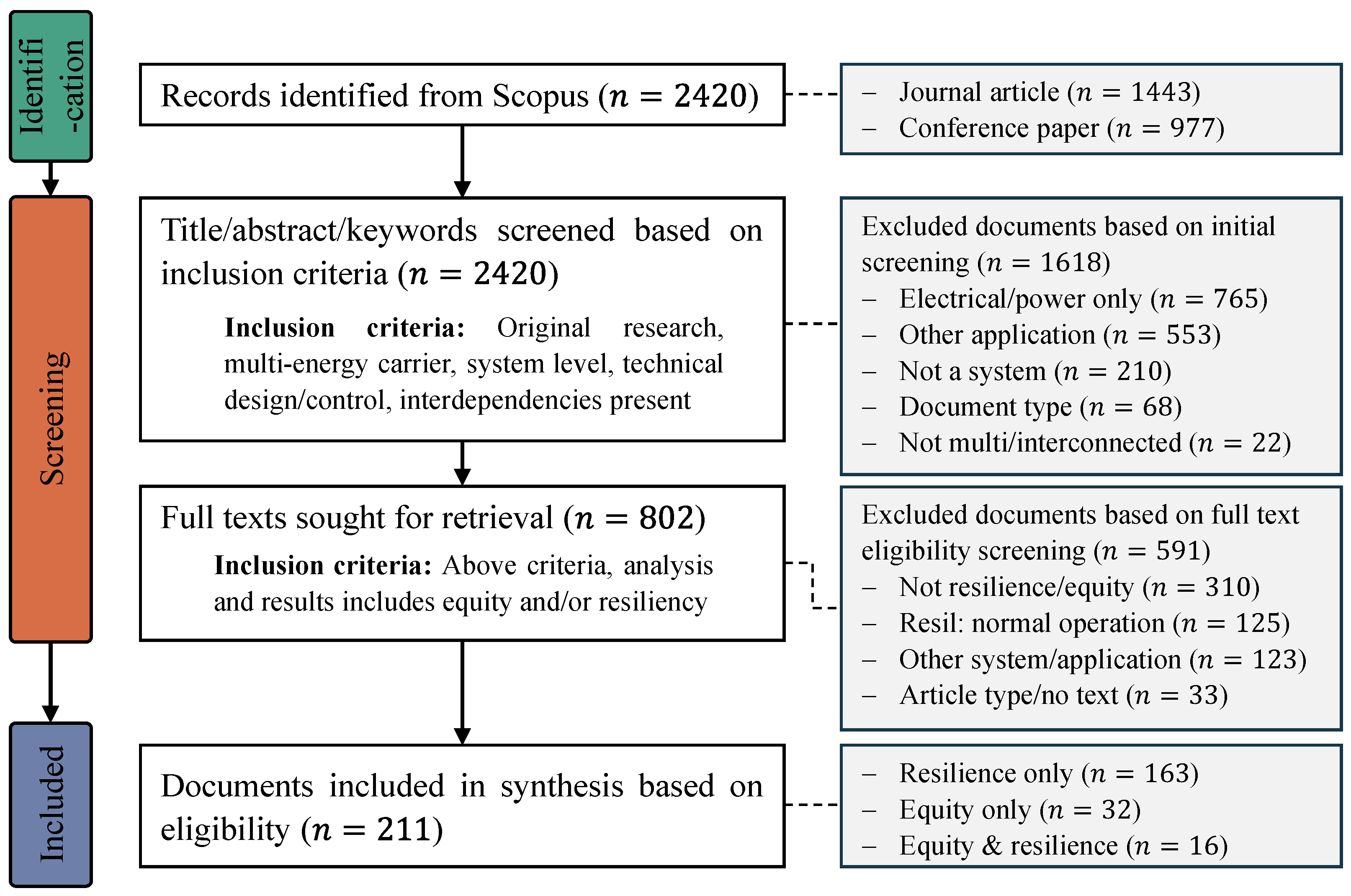
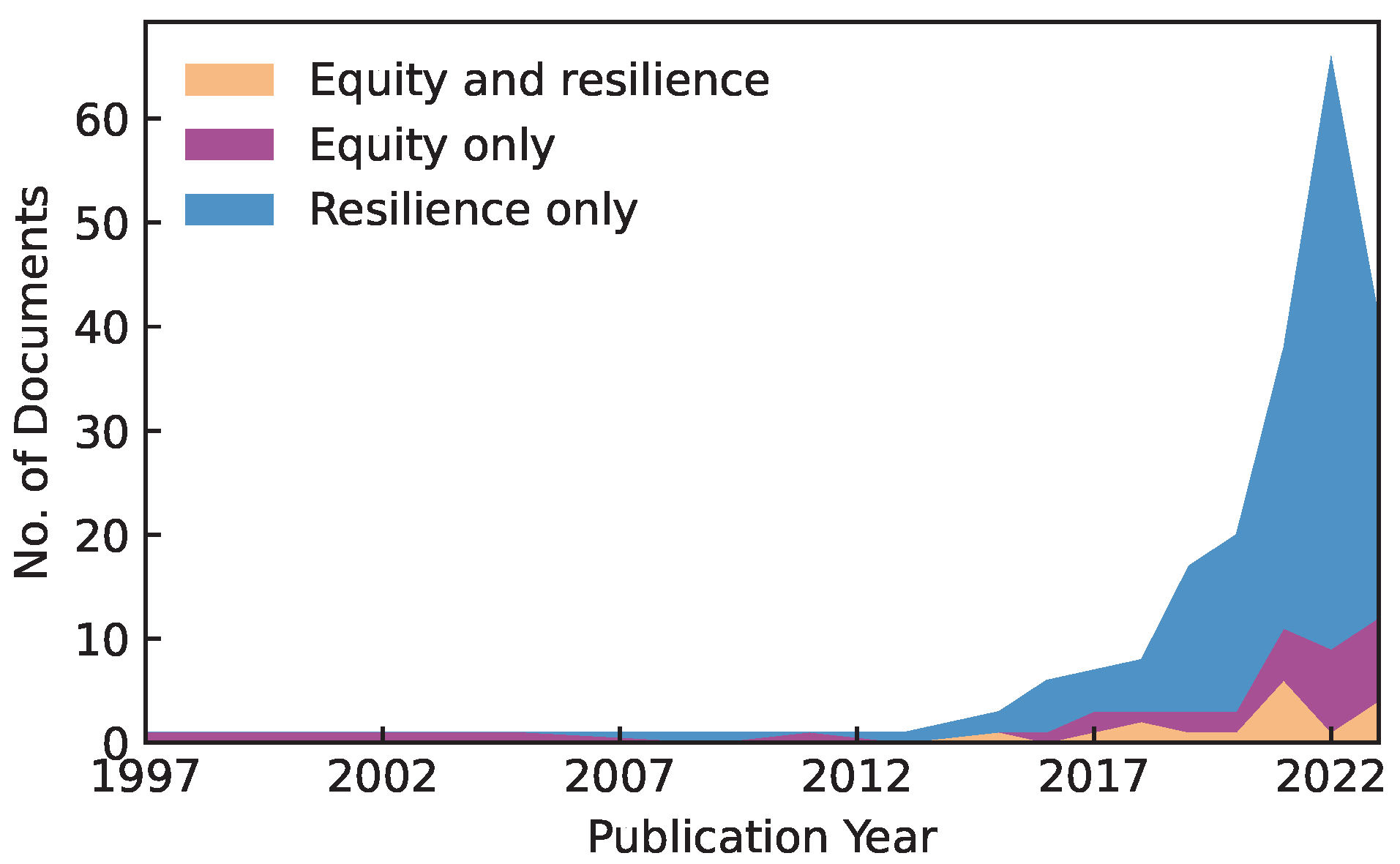
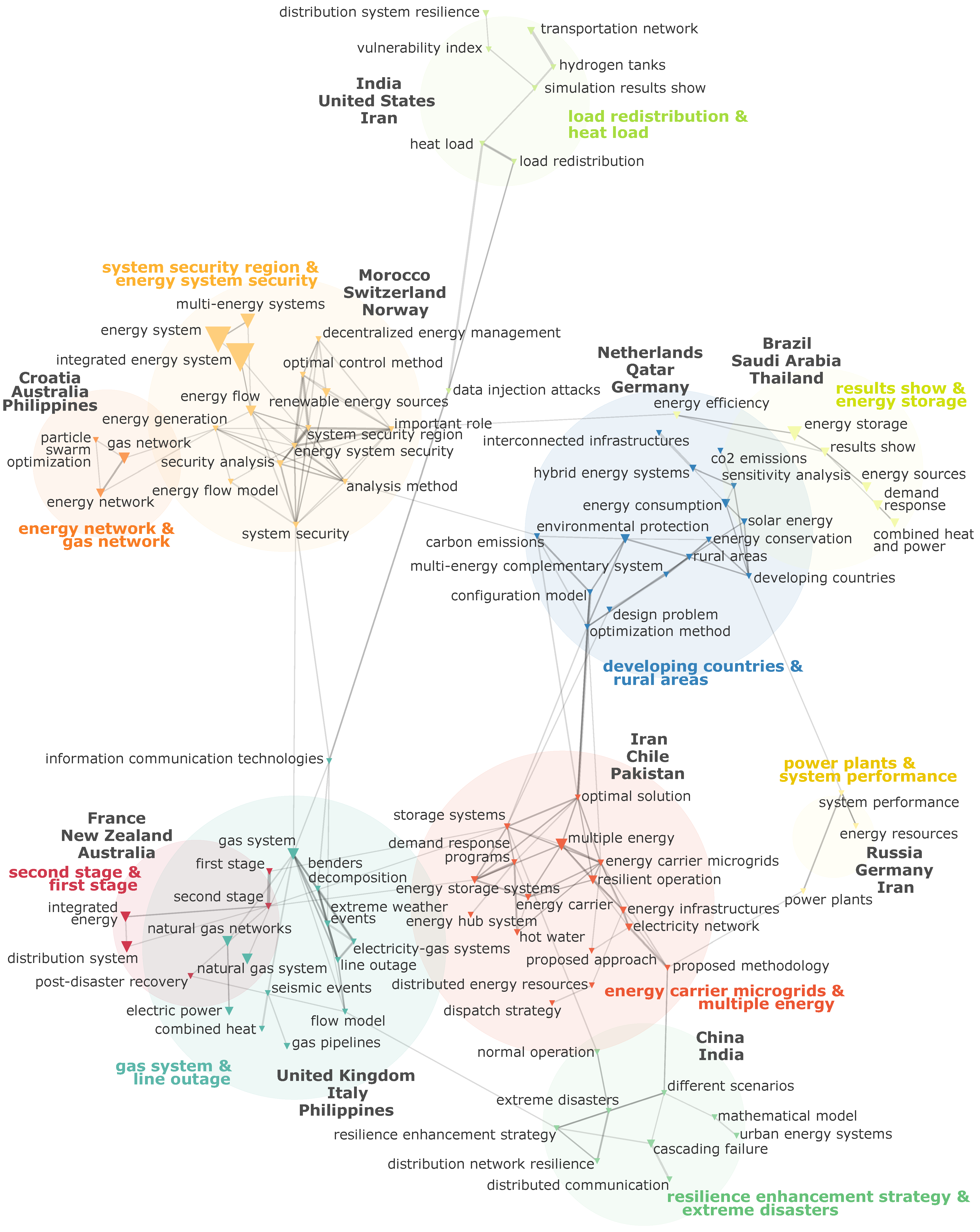
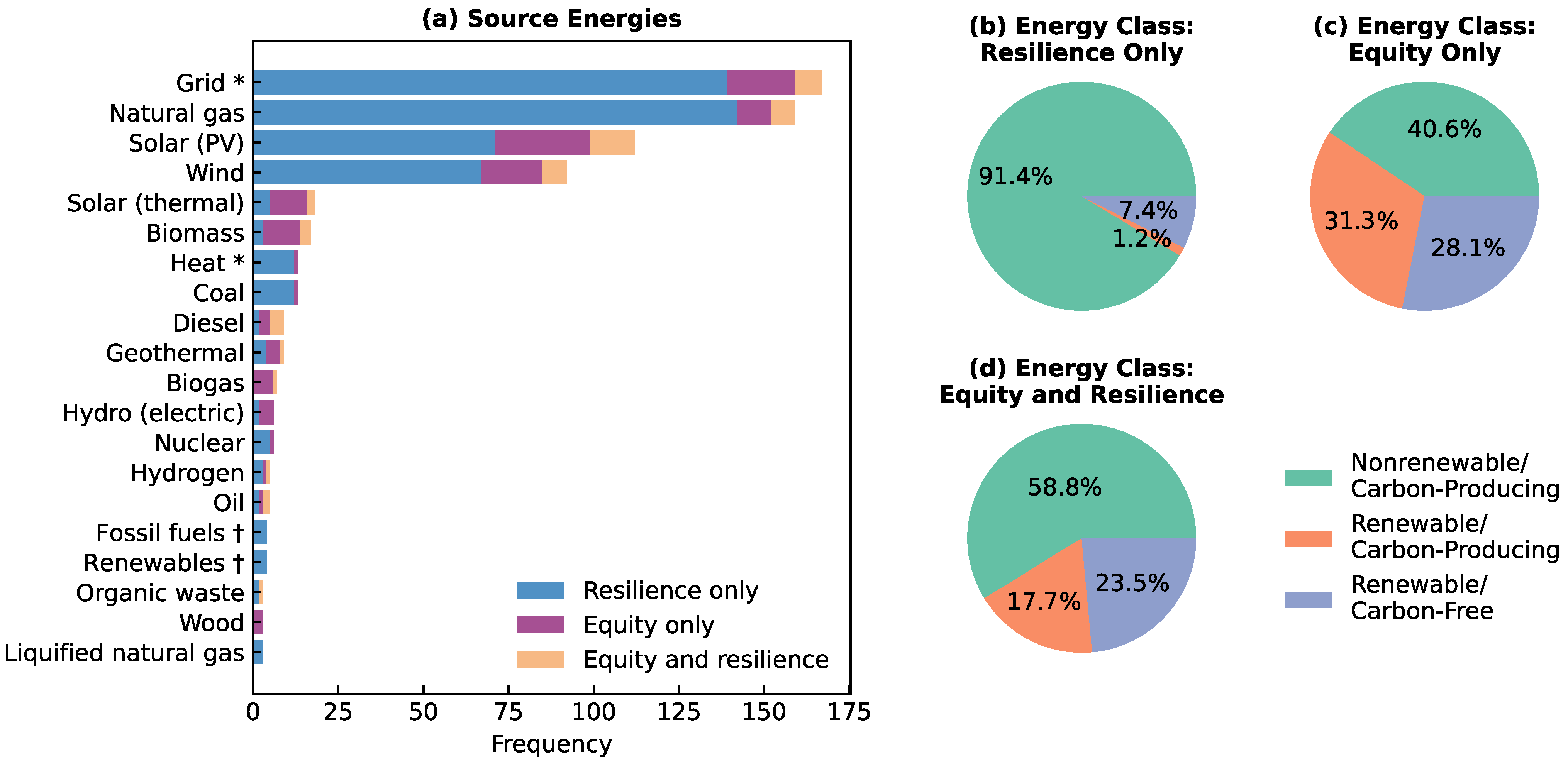
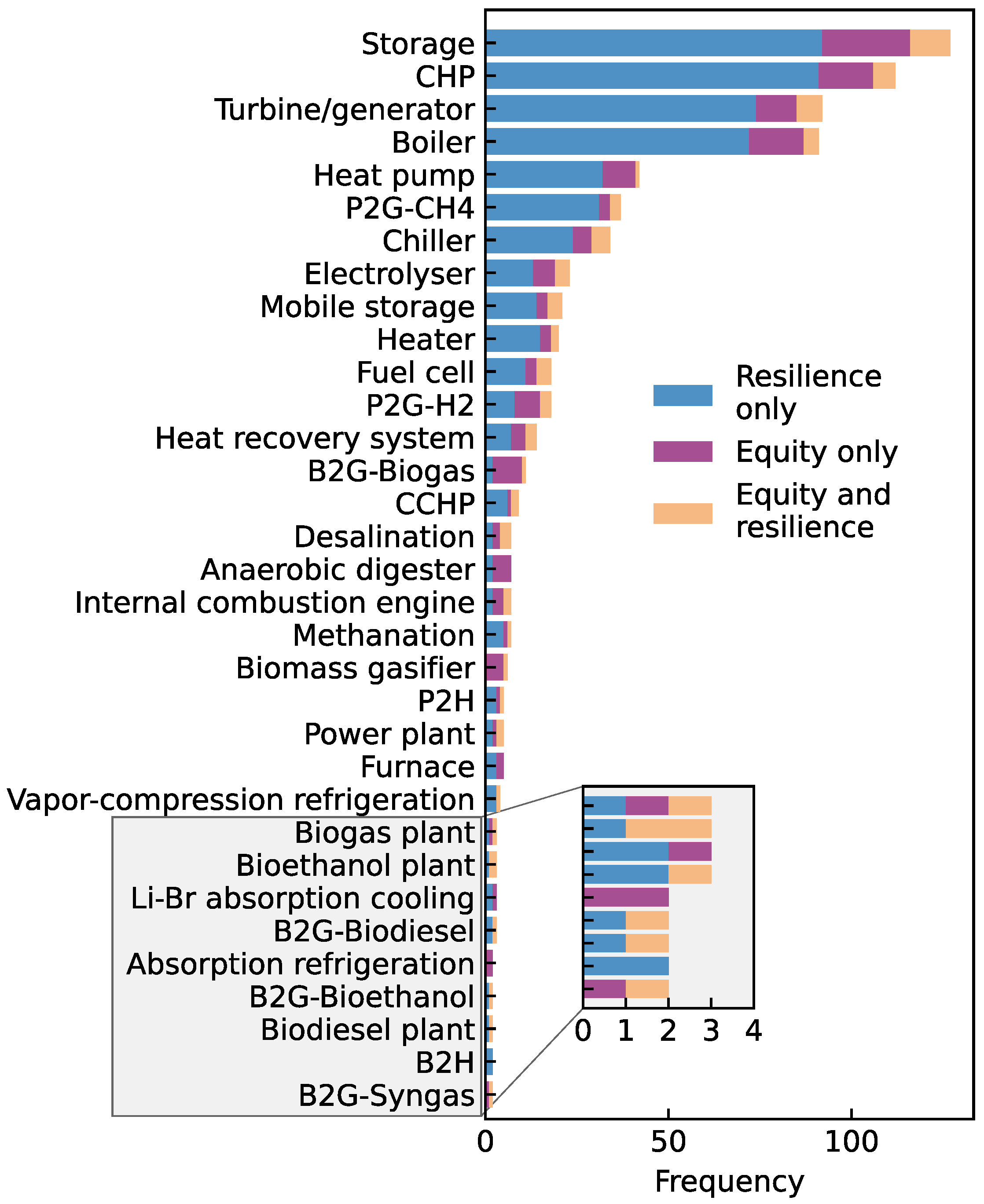
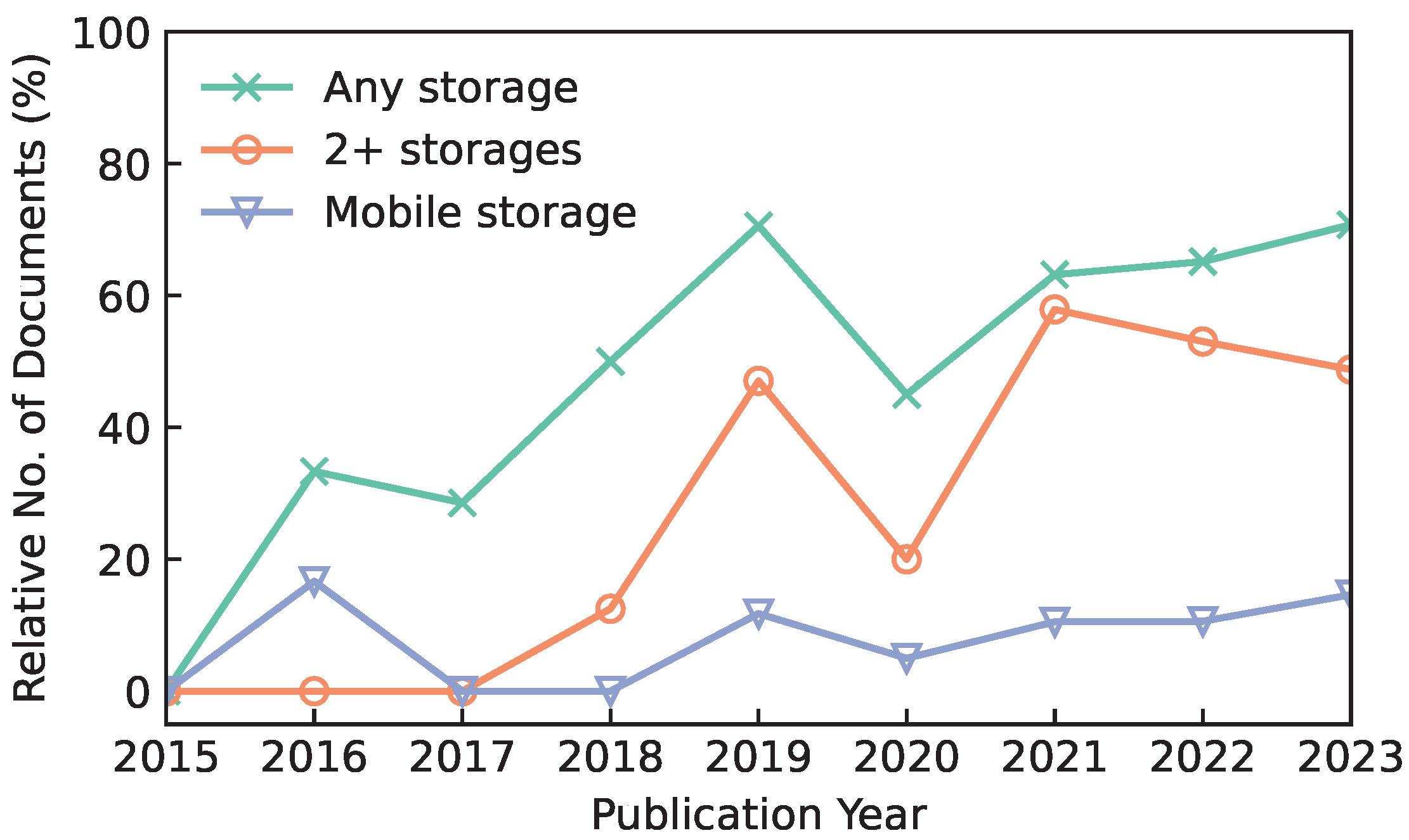


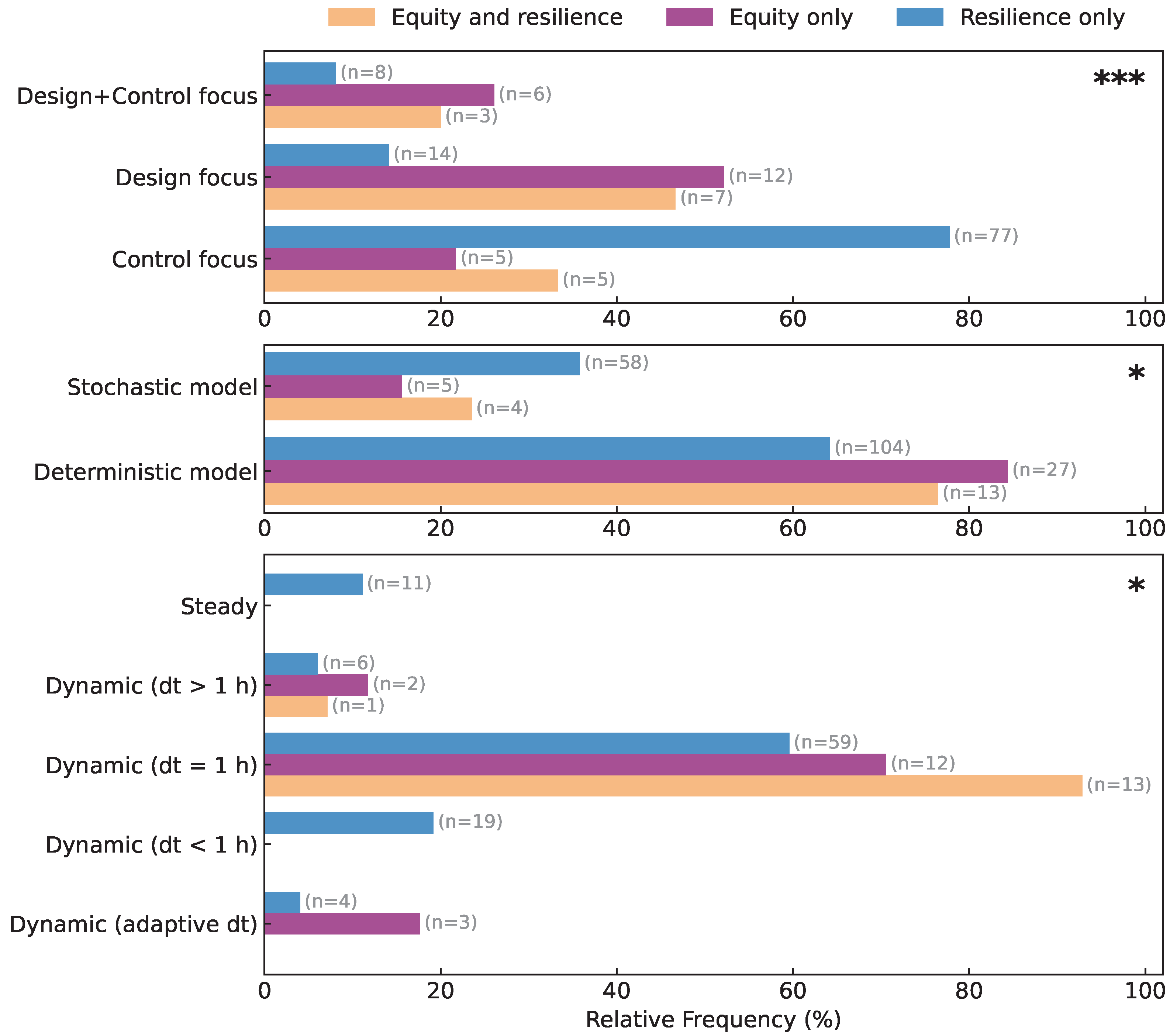
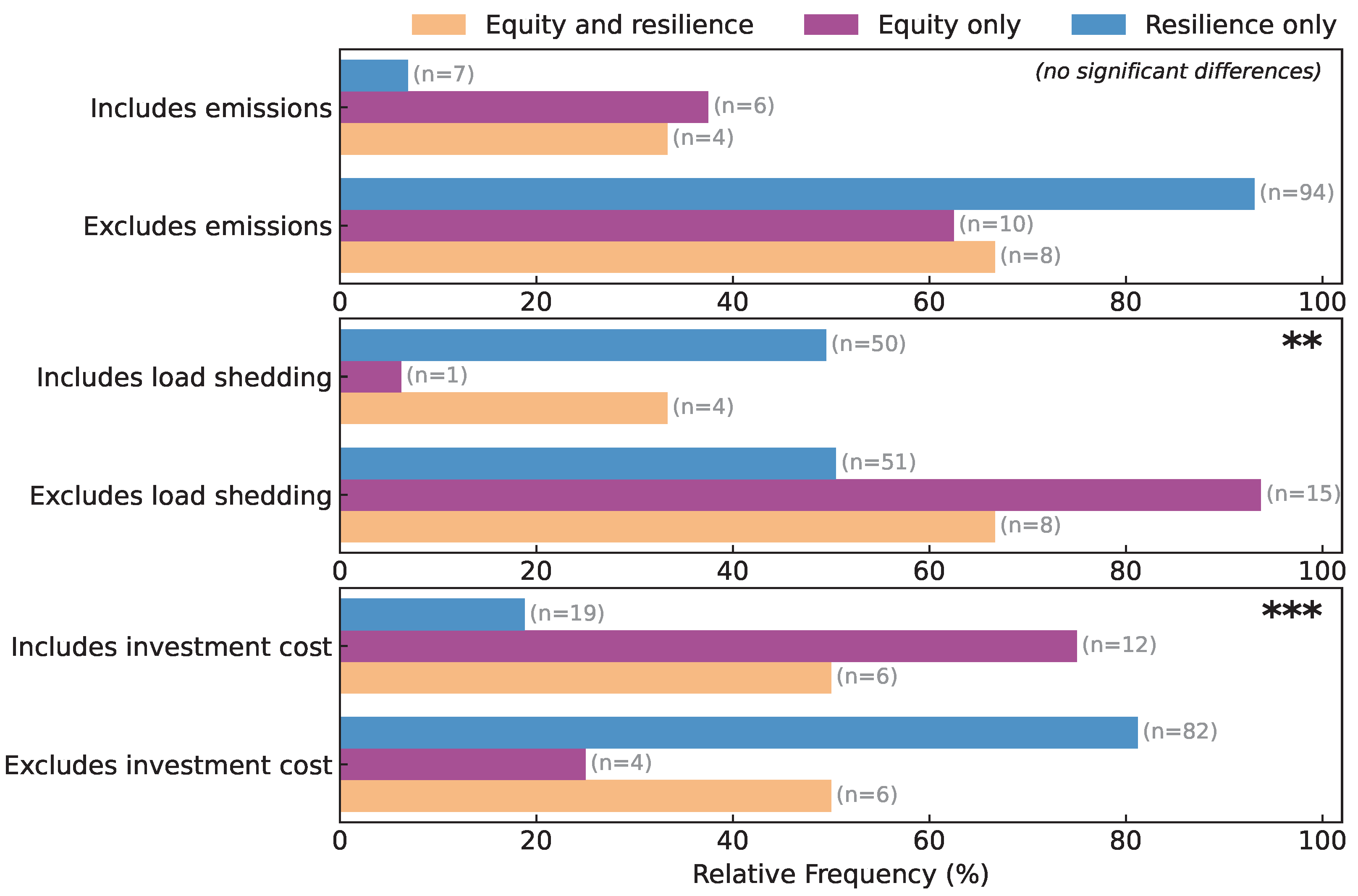

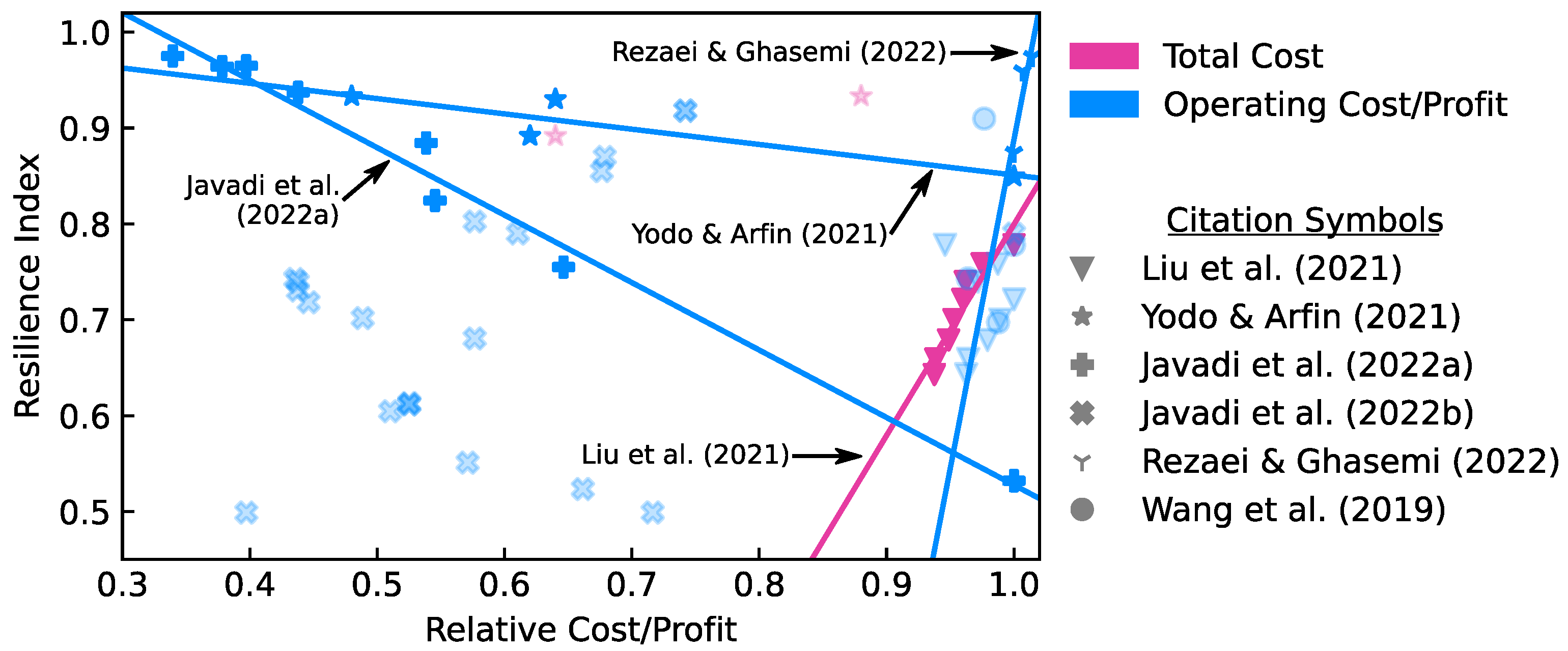
| or | and | or |
|---|---|---|
| multi-energy, multiple energy, energy hub*, integrated energy, interconnected energy, hybrid energy | resilien*, vulnerab*, disadvant*, protect*, secur*, *equality, equit, justice, developing countr*, underdeveloped countr*, low-income, afordab* |
| Category | Variables | |
|---|---|---|
| Physical Systems | Energy class | nonrenewable/carbon-producing, renewable/carbon-producing, renewable/carbon-free |
| Source energies | grid, natural gas, solar (thermal), wind, biomass, etc. | |
| Equipment | boiler, chiller, CHP, anaerobic digestion, mobile storage, etc. | |
| Networks | electric, heating, cooling, transportation, gas, etc. | |
| End uses | electric, heating, cooling, gas, etc. | |
| Research Approaches | Scope | equity only, resilience only, equity and resilience |
| Scale | building, district, region | |
| Location | Geographical coordinates of the case study site | |
| Income level | Country-level income classification of case study site | |
| Climate | Köppen climate classification of case study site | |
| Software | MATLAB, GAMS, Python, etc. | |
| Model type | MILP, MINLP, ODE, etc. † | |
| Model formulation | dynamic or steady; stochastic or deterministic; linear or nonlinear | |
| Time step () | time increment assumed for dynamic models | |
| Engineering stage | planning, design, control/operation | |
| MOO method † | weighs, levels/stages, Pareto front, single | |
| Optimization objective | metric(s) being minimized/maximized in the study | |
| Key metrics | life cycle cost, resilience index, total shifted load, etc. |
| Term | Frequency | n |
|---|---|---|
| energy storage | 56 | 41 |
| demand response | 26 | 20 |
| combined heat and power | 23 | 23 |
| cascading failure | 19 | 12 |
| environmental protection | 18 | 12 |
| renewable energy sources | 17 | 14 |
| transportation network | 16 | 9 |
| distributed energy resources | 13 | 10 |
| CO2 emissions | 12 | 8 |
| extreme weather events | 11 | 9 |
| Climate Group | n |
|---|---|
| A (Tropical) | 5 |
| B (Arid) | 13 |
| C (Warm temperate) | 56 |
| D (Snow) | 16 |
| E (Polar) | 2 |
Disclaimer/Publisher’s Note: The statements, opinions and data contained in all publications are solely those of the individual author(s) and contributor(s) and not of MDPI and/or the editor(s). MDPI and/or the editor(s) disclaim responsibility for any injury to people or property resulting from any ideas, methods, instructions or products referred to in the content. |
© 2025 by the authors. Licensee MDPI, Basel, Switzerland. This article is an open access article distributed under the terms and conditions of the Creative Commons Attribution (CC BY) license (https://creativecommons.org/licenses/by/4.0/).
Share and Cite
Hinkelman, K.; Flores Garcia, J.D.; Anbarasu, S.; Zuo, W. A Review of Multi-Energy Systems from Resiliency and Equity Perspectives. Energies 2025, 18, 4536. https://doi.org/10.3390/en18174536
Hinkelman K, Flores Garcia JD, Anbarasu S, Zuo W. A Review of Multi-Energy Systems from Resiliency and Equity Perspectives. Energies. 2025; 18(17):4536. https://doi.org/10.3390/en18174536
Chicago/Turabian StyleHinkelman, Kathryn, Juan Diego Flores Garcia, Saranya Anbarasu, and Wangda Zuo. 2025. "A Review of Multi-Energy Systems from Resiliency and Equity Perspectives" Energies 18, no. 17: 4536. https://doi.org/10.3390/en18174536
APA StyleHinkelman, K., Flores Garcia, J. D., Anbarasu, S., & Zuo, W. (2025). A Review of Multi-Energy Systems from Resiliency and Equity Perspectives. Energies, 18(17), 4536. https://doi.org/10.3390/en18174536






